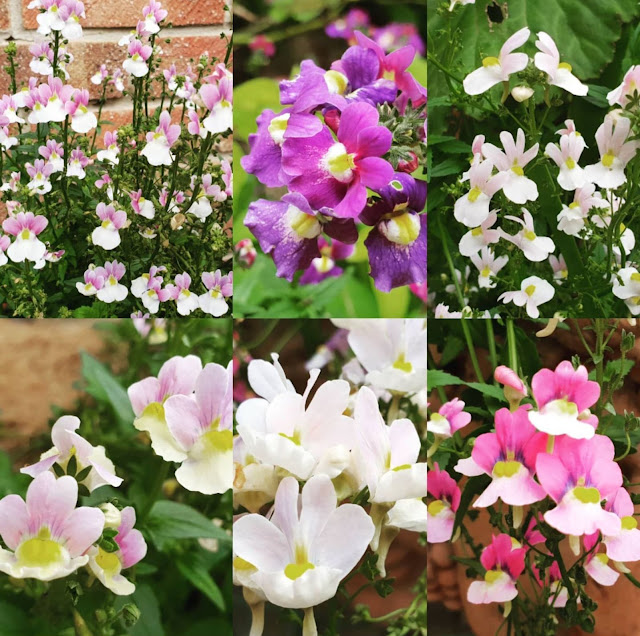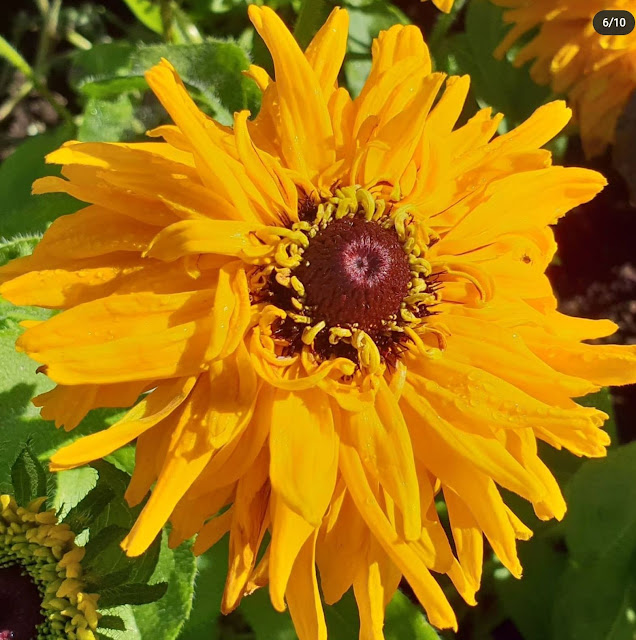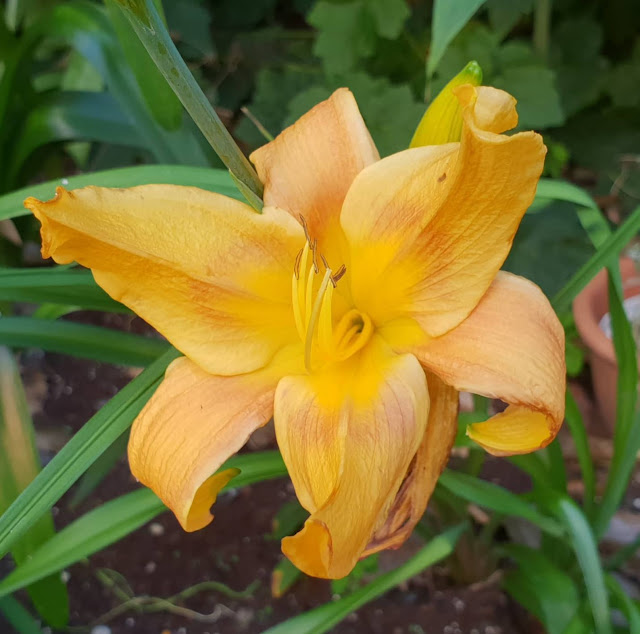I can't claim great success with ipheions in pots. They have grown lush in leaf and flowered erratically. This year I've divided them, hardening my heart and discarding the surplus, and this morning gave the various pots a dose of slow release fertiliser. My favourite is 'Jessie' for its deep neo-blue. I don't like the garlic smell of the leaves though that is a non-issue for all practical purposes. I've laughed at some of the descriptions of the starflowers from sellers; I've not noticed any honey fragrance, for instance. However in the depths of winter the plants throw out the odd flower and can seem truly exotic in that context. When the sun shines and massed blooms appear they are pretty things indeed. Three in close-up: 'Rolf Fiedler', 'Charlotte Bishop' & 'Jessie'. Plus 'Wisley Blue' in the garden.
“Snowdrops and my heart I’ll bring” (Christina Rosetti) ... a blog about snowdrops .............. plants ... seasons .... gardens ....
My Snowdrop Year
I'm attempting to move my snowdrops from pots to borders out of necessity. I have too many. However in the meantime here is a photograph of one of the racks replete with weeds to trigger a quick synopsis of my snowdrop year which commences after flowering when I split up the clumps and, in this case, transfer from pot to border. The second image shows a newly planted area of the garden, beefed up with compost and divided snowdrops, cyclamen and daffodils. If I remember I'll feature this very spot in the spring. The pots have been fed with slow release fertiliser, so all I do is water them frequently. I have discovered the perils of compost drying out when the bulbs are busy plumping up. After the bulbs go into dormancy I repot at my leisure, mixing potting compost, grit and vermiculite. This can be an ordeal as it is depressing to root through compost to discover not discover a solitary bulb, perhaps the remains of bulbs or grubs of the narcissus fly. E.A. Beale has disappeared from two pots, the third and final time I'm growing the damn thing. Anyway, I discard any soft ones, and where there is any sign of rot apply a fungicide I was given by a friend. About now the autumn flowering ones are placed in a prominent position and I move the rest into a sunny area. Labels are a bete noire because they go walkabout. Then of course there's the little matter of adding to my collection. I only have three new ones this year, a major change. Only very distinctive snowdrops will be added. I've certainly started to diversify. Bavk to the photograph of the pots. Plastic pots on top, terracotta ones at the bottom to ballast the racks. I'm not risking another collapse. And finally, the last man standing this year, a little glum in the wet.
Rosa 'Birthday Girl' - Top Performer
Redesigning the garden has meant sacrificing some roses. However 'Birthday Girl' is not one. It has been a magnificent rose, repeat flowering in profusion, fresh and bright. I have read that it makes a good hedging plant: true enough I'm sure but for me it is a feature not a boundary. Standing at a modest 3ft it needs no support and seems disease free. It was bred by that prolific French nursery Meilland and released in 1992. A good, commercial name too for that garden centre birthday gift. I photographed it on 20th May when it first bloomed and it continued to autumn. Meilland has been around since 1850 and bred some mammoth successes - 'Peace' ('Madame A Meilland'), 'Papa Meilland'.
Fritillaria meleagris
Another fritillaria today. I have no idea what happened to our white form of Fritillaria meleagris though I suspect unintelligent weeding accounted for the lot. Like a number of plants I've featured lately they are a member of the lilaceae family and a plant even the uninitiated notice in the garden. The Snakeshead Fritillary is named after the chequered, tessellated pattern - fritillary means chequered. They flower in light shade in our backgarden and I confess I sometimes mistake their leaves for grasses when I'm tidying up. I have planted some more of the 'Alba' form expecting to see them unmolested in April. There is some variation in the colour. I've posted two images from April 1st though sadly no white one.
Fritillaria imperialis “William Rex”
The crown imperial is well named. It is a dominant plant in the spring border. You smell it before you see it - quite a feat given its size. I'm sure the neighbours believe I'm smoking something I shouldn't. The skunky smell deters deer, cats, rodents, delivery drivers and burglars. All right, I exaggerate - the latter like the smell. Fritillaria imperialis “William Rex” has a lovely bronzy-red colour. I wouldn't want a garden full otherwise we would fail to have deliveries.
Gloriosa 'Tomas De Bruyne'
Colchicums - 'Purpureum', 'Byzantium', 'Autumnale' and 'Dick Trotter'
Colchicums lighten the garden as we move into winter. I have quite a collection. These are not in any order because I'm no authority but 'Purpureum', 'Byzantium', 'Autumnale' and 'Dick Trotter' are shown flowering today. They were photographed in pots but are now planted in the borders and mixed in with daffodils, snowdrops and spring flowering crocus. Friends dropping a parcel off this afternoon commented on the size of the front garden now the central bed is missing but had most to say about the autumn crocus. When flowers are so flamboyant at this time of year their membership of the lily family is clear to see.
Nemesia from self-sown seed
I bought four nemesia plants four years ago and have been treated to literally hundreds of new plants since then and, strangely enough, there's been a decent variety of colours, most with that delicious vanilla fragrance that carries in the air. They seed in plant pots and in the cracks between the patio flags. The seedlings are easy to distinguish from weeds - something I've apparently not done with one or two valuable perennials lately. And I like the soft colours. They look great in hanging baskets. The little detail was photographed on the 23rd March. The whole plant had over-wintered. Hardy gems. One of my favourite plants.
Harlow Carr's Rudbeckia Trial
My wife's favourite flower is the Rudbeckia. Well, certainly for autumn though I'll punt for the dahlia. It cannot be denied that the burst of beaming yellow dominates the border in September and October. They look sensational. The photographs were taken on 31st August at RHS Harlow Carr from their trial of varieties grown from seed. They intend to leave them to see how many of the annuals survive the winter. Sadly I note that Thompson and Morgan have sold out of their mixed seed. Chiltern Seeds have their own mix however.
Papaver Orientale 'Pink Perfection'
Difficult decisions today or rather yesterday - I work in arrears - as the turf was laid on our front garden, the large island bed covered up and its plants moved elsewhere. It's always difficult for me to throw plants away. And I have the taproots of a rather lovely oriental poppy, Papaver Orientale 'Pink Perfection', that has been with us for a decade or so. Poppies tend to be short-lived but nobody told this version; the oriental poppies are long lived and resent disturbance. It really is an exotic bloom though it doesn't flower for long I'm afraid. However when in bloom it is special. Anyway I've retained some healthy carrot-like taproots and will give them a go in the new border. Meanwhile I was out in the drizzle using up the remainder of the turf to edge the lawns where plants had encroached onto its space. Waste not want not. Which also applies to the bulbs salvaged from the contractors' wheelbarrow.
Late Flowering Hellebores
Hellebores provide great value for the winter months and extend into Spring. I've just been moving a number and they have distinct shoots, one double white showing colour. However it is the long period of flowering that I'm covering today. Here is a selection from 18th March. Bottom left is my favourite, 'Janys', named after my wife though the double white is delectable. I lost the original but it had seeded itself and they have stayed true to the parent. Top left shows the white fading to an attractive green though the top middle retains its colour. I cut down the rather coarse leaves as they come into flower and it does not harm the plants.
Garden Ornaments
Two planted heads today. First is the newest ornament in the garden, bought from Ebay on impulse, photographed on 12th June, and planted with a trailing succulent that seems to withstand the roasting sun on the south facing wall. The flower was a bonus. Next up is a forty year old terracotta cat planted with the fuschia 'Eruption', 30th April vintage, that failed to erupt in cat, and also hanging baskets. The sun shrivelled the young plant in the cat and other plants in the hanging baskets submerged the remainder. I replanted the cat with a trailing nemesia that could take the heat.
Galanthus 'Remember Remember'
I have posted shots of this early flowering variety before and I am aware of some users of Instagram revealing even earlier flowering specimens but this, as they say, does for me. I have had several even earlier varieties showing already though 'Remember Remember' is the first truly significant one to feature here at a time when preparing the garden for winter has stripped away the colour. The dahlias were put to bed yesterday. The photograph was taken with my Nikon D3500 and a Nikkor 105mm lens. Discovered in a garden in North Green, Suffolk, in 1992, an interesting article about it may be discovered here.
Narcissus Van Sion, Division 4, Double Daffodil
I have featured some old varieties of narcissus on these pages though no older than Van Sion, chosen to illustrate Division 4, the double daffodil of garden origin. The description is defined thus: More than one flower per stem, with doubling of the perianth segments or the corona (or both). This ancient variety is very variable, indeed it can have a distinctly green cast and I had neater specimens than this, photographed on 20th March. In his seminal 'A Handbook of Narcissus', published in 1934 EA Bowles gave a historical perspective on the age and origins of this great survivor: “Its first appearance in England is that chronicled by Parkinson, who tells in the Paradisus that Vincent Sion, a Fleming, living in London, cherished it in his garden for many years before it flowered in the year 1620. He thought that John de Frauqueville might have given him the bulb, but that worthy disclaimed the honor, never having seen the like before." Tough as old boots and very reliable, there's a certain charm in having such an historical bulb in our garden.
Hemerocallis: Thoroughly Modern Lily
The humble day lily was neglected in our garden. They seemed an old fashioned plant, a legacy of the Victorian age. I'd see them in other gardens, crammed, dense and only a few flowers, a plant that quickly grew out of control. However if ever the hybridisers have got involved in a plant it's with the hemerocallis. There are thousands of varieties out there and the names are fabulous too. Thoroughly Modern Lily. So I have about twenty specimens grown in the borders and pots. 'Little Grapette' flowered in a terracotta pot by the patio window, whereas 'Frans Hals' flowered profusely in a sunny border. Where I placed them in partial shade they have been disappointing. The individual flowers last no more than 24 hours but there's a succession of always fresh blooms. Our plants are generally new though already forming clumps that I'll have to keep an eye on as my space is limited. What I have discovered is that they don't enjoy competition in their early months. A clump is a different matter of course. As they are not actually lilies those damn red beetles pose no problem. And some varieties of day lily possess a pleasant fragrance. Most importantly in our garden they give that tropical, bright colour at a time when we are denied travel to foreign shores. For the record, 'Little Grapette' was photographed on 14th August, 'Frans Hals' on 28th July.
Meconopsis 'Mop Head'
The blue poppy is the great Houdini in my garden because it has perfected a disappearing act. I'm in the process of completely redesigning the front garden, eliminating the island bed and widening a border to compensate. Scrabbling around for specimens to relocate I have been disappointed to discover two varieties have just disappeared without trace. Still, two specimens are left and 'Mop Head' was the earliest and though it has died down now there's life there yet for another year. Meconopsis are short lived plants however and, to make matters worse, 'Mop Head' produces little seed. (I must divide it up in Spring!) It is a classy looking variety however with very large upright flowers and it flowers earlier than most. The photograph was taken on the 11th May. A couple of years ago we saw the trial of blue poppies at RHS Harlow Carr. I noted the name and was not surprised when I discovered it had the coveted AGM. However 'Mop Head' has been around for years. In the 1980s Liz Young acquired the seed from an exchange scheme with members of the Scottish Rock Garden Club, naming it in 2007, the first link being to the Meconopsis Group. I'd recommend both groups. I'm a member of the first.
Galanthus 'South Hayes'
'South Hayes' was for a time the most expensive snowdrop in our garden - nowadays I tend to swap but that's another story. I've had the bulbs for years and, truthfully, they are more beautiful than many recent varieties costing far more. Unlike the narcissus I have been writing about lately 'South Hayes' was not the result of painstaking hybridization. It was discovered in 1992 in the Oxford garden of Primrose Warburg, a noted galanthophile, and husband, William Frederic ‘Heff’ Warburg, a professor of Botany. The rear garden slopes dramatically and in the trenches of moist soil the plants seeded freely. The lovely yellow snowdrop, 'Primrose Warburg', named after the owner was another chance seedling. Interestingly, the now rather neglected garden has just been redesigned by Sarah Naybour Design. I've reproduced a 'before and after' photograph. An interesting article about Primrose is that in The Gardener's Apprentice. The photograph was taken on 21st February.
Narcissus 'Cape Cornwall' Division 2 Large-Cupped
A recent post concerned the demise of Cornwall's world renowned bulb industry as the world famous daffodil fields were grubbed out for food production during WW2. I thought about this and remembered that Cornwall still has one of the world's top hybridisers in Ron Scamp - the link is to a 'Country Life' article about him. So appropriately enough I chose one of his introductions 'Cape Cornwall' as representative of Division 2, large-cupped daffodil cultivars - one flower to a stem; corona (cup) more than one-third but less than equal to the length of the perianth segments (petals). 'Cape Cornwall', photographed here on 13th April, was introduced in 1996 and, true to type, has a large flower that is very bright and modern. Ron sells his bulbs by mail order and has plenty of new introductions, sadly sold out as I write.
Dahlia 'Yellow Star'
There are plants that generate their own inner light and the truly exquisite dahlia 'Yellow Star' does just that. I cut down the plant this afternoon with a heavy heart as it was still laden with blooms. However contractors arrive any day now to remove what used to be a rockery from the front garden and everything has to be cleared. The tubers were healthy and are now in a good sunny spot with compost heaped above it for frost protection. I was tempted to store them in the shed but I've been lucky so far. Dahlias are great garden plants for late summer to the frosts; I just require them to survive winter. 'Yellow Star' goes back to 1952 introduced in the USA by Robens about whom I'm afraid I can discover zilch.
Narcissus 'Avalanche of Gold' Tazetta - Division 8
I set out to see if I had representatives of all the 13 different classifications of narcissus varieties. Today it is the Tazetta daffodil and a tribute to the breeder of the very lovely 'Avalanche of Gold', William R. P. Welch who died in February at the age of 61. First the classification. This is a showy category, defined as 'usually three to twenty flowers to a stout stem; perianth segments spreading not reflexed; flowers usually fragrant'. I have several and was tempted to feature the well known 'Minnow' or 'Silver Chimes'. But 'Avalanche of Gold' won the day. A spectacular garden plant, photographed here on 22nd March, it has a spicy scent and between eight and fifteen flowers to each stem. Growing and selling his bulbs in Santa Cruz, Bill 'Bulb Baron' Welch seems to have been quite the character as his orbituary demonstrates. He was a witty man and a bright one, winning several major chess championships. His bulbs were his 'bildren'. Given that the bulbs take up to seven years to raise from seed, he had a work ethic as well as wit. In 2019 he was awarded the Gold Medal of the American Daffodil Society. The image is of Bill taken from the society's webpage. 
















































